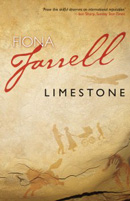

Vintage (Random House NZ), paperback, 9781869791681
Although the latest novel by award winning New Zealand writer Fiona Farrell seems slight and fairly unassuming in appearance, within its pages Farrell dwells on the "big" issues—why are we here, who made us, what are we and where are we going. The sedimentary rock we commonly refer to as limestone is the central metaphor running throughout the narrative. This instantly recognizable white rock is composed of the skeletal remains of tiny marine fossils, and takes millions of years to form. Found throughout the world (the pyramids in Egypt are made of limestone), in Farrell's novel it is limestone which eventually links the New Zealand narrator to her father's hometown in Ireland.
Clare Lacey is an art historian who grew up in the small seaside town of Oamaru, on the west coast of the South Island of New Zealand. Renowned for its stunning white stone, Oamaru is a town both built on and in limestone. Clare's early childhood in Oamaru was marred by the disappearance of her Irish father, a charming signwriter who also just happened to know how to build sturdy limestone fences. One day Mick Lacey walked out to buy a pack of cigarettes and never came home again, leaving Clare's earnest young mother to raise three young children on her own.
Now in her late forties, Clare is facing a number of personal crises. Both her mother and her wayward younger brother are dead, and her younger sister is estranged from her. The man Clare has had her longest relationship with has suddenly discovered God and has left her to live in a commune in India. Clare, herself, is suffering from a genetic bone disease which may one day severely limit her activities. It seems like the time has finally come for Clare to discover the truth about the mysterious man who "fathered" her and yet, by walking out, refused to be her father.
Clare goes to Ireland in order to attend an art history conference, but once she arrives in Cork she decides that this time she will be the one to abscond. She goes in search of her father's birthplace, in the hope that there she will find clues about why he walked out on her family and what happened to him subsequently. Like a geologist or an archaeologist, Clare is desperate to uncover the layers of personal history and mystery that have enveloped her family, Inevitably she discovers only tiny kernels of truth but they are enough to have her re-examine the layers of her own life. And, of course, in a 21st century novel about family relationships there can be no happy ending but there can be some sense of resolution.
While the story of Clare's family is intriguing enough to sustain the reader's interest on its own merits, what makes Limestone
so powerful is the beauty of the language. Fiona Farrell is also an accomplished poet and her use of language in this novel
is reminiscent of that exquisite wordcraft exhibited by Louis de Berniere's Captain Corelli's Mandolin. The entire
first chapter is a rhapsody on limestone—one that you would not want to miss—and it could just as easily be poetry
rather than prose. While Clare is not always a likeable character, there is much to like about Limestone and it is,
therefore, not surprising that it is one of the three novels shortlisted for the most prestigious annual fiction prize in New Zealand.
